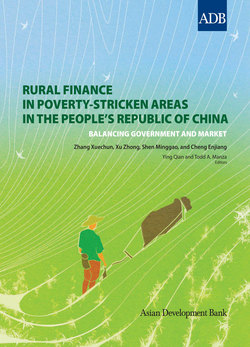Читать книгу Rural Finance in Poverty-Stricken Areas in the People's Republic of China - Xuechun Zhang - Страница 16
На сайте Литреса книга снята с продажи.
A New Rural Financial System: Satisfying Multilayered Financial Needs
ОглавлениеThe new type of rural finance is based on industrialization, urbanization, and the building of a new rural countryside. It serves more than just sannong, and the financial service providers include both RCCs and a variety of financial institutions. At present, the opening of the rural financial market in poor areas provides new opportunities for the development of rural finance, and a brand-new era is unfolding. In May 2005, the People’s Bank of China launched pilot microfinance lending companies in Guizhou, Inner Mongolia Autonomous Region, Shaanxi, Shanxi, and Sichuan, signaling a key step forward in the opening of rural finance. In December 2006, the China Banking Regulatory Commission issued an opinion on reforming RCCs and encouraging banking financial institutions to increase their presence in rural areas. In addition, permission was granted to form three new types of rural banking financial institutions: village and township banks, community credit cooperatives, and lending companies. Gansu, Hubei, Inner Mongolia Autonomous Region, Jilin, Qinghai, and Sichuan pioneered the pilot programs, and if these turn out to be a success, a series of grassroots financial innovations will promote bottom-up rural financial reform.
The new rural finance may encompass several rural financial innovations and services. The first innovation is in financial services for microenterprises or individual businesses, which encourages entrepreneurship and represents an important means of increasing the employment and income of farmers. To date, such financing needs have been met through informal lending. The emergence of microfinance institutions, lending companies, and village and township banks signifies the partial legalization of informal finance and diversifies the available financing channels.
The first innovation is in financial services for microenterprises or individual businesses, which encourages entrepreneurship and represents an important means of increasing the employment and income of farmers
Second, with rapid economic development and urbanization and the resulting decrease in the farming population comes the opportunity to develop large-scale plantation and animal husbandry enterprises, which may become the most important elements of production. At the same time, prices for agricultural produce have increased in recent years, so such enterprises have good prospects and have become major recipients of rural credit. More importantly, some specialized farmers’ associations will become carriers of credit, linking borrowers with lenders. The combination of rural lending shops with specialized production organizations will become a major form of rural finance in the future.
Third, the transformation of farmers into city dwellers and the steady cash flow of migrant workers in urban areas during the process of urbanization will generate a heavy demand for consumer credit. Farmers will need funds for their children’s education, for homes, for marriage, and for the purchase of durable consumables. Financial institutions can design relevant financial products to provide farmers with consumer credit. With migrant workers’ cash flow as a guaranty, the risks of consumer credit are controllable.
Fourth, sannong must be supported in a commercially viable manner, guided by fiscal policies and based on laws such as the Community Reinvestment Law that encourage financial institutions to tap the rural credit market in poor areas. Credit support for sannong should be a goal of the government rather than of financial institutions. For example, the government wishes to expand credit coverage for low-income populations and lift them out of poverty. However, due to the high credit risks associated with low-income populations, any financial institution is bound to ask for a relatively high-risk premium in the form of a high interest rate, government-subsidized interest, tax reductions, or other preferential policies. Only in this way can government objectives to support sannong be combined with the functions of financial institutions. In fact, not only the Agricultural Bank of China but also other financial institutions and investors should be encouraged to participate in the process of supporting sannong at the wholesale or retail levels.
Finally, there is a growing demand for wealth management in rural areas. Farmers’ increased income improves their ability to accumulate wealth and increases their need for wealth management. The wealth management market in the PRC will gradually expand from cities to rural areas. Suitable wealth management products can improve farmers’ property gains and generate intermediary commissions for financial institutions, representing an important future component of rural finance.
